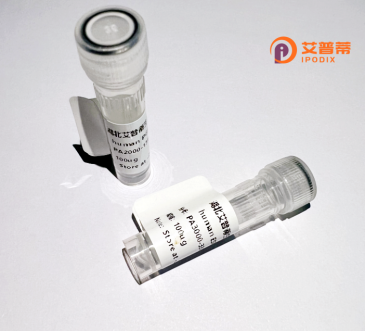
| 纯度 | >90%SDS-PAGE. |
| 种属 | Human |
| 靶点 | DLX1 |
| Uniprot No | P56177 |
| 内毒素 | < 0.01EU/μg |
| 表达宿主 | E.coli |
| 表达区间 | 1-255aa |
| 氨基酸序列 | MTMTTMPESLNSPVSGKAVFMEFGPPNQQMSPSPMSHGHYSMHCLHSAGHSQPDGAYSSASSFSRPLGYPYVNSVSSHASSPYISSVQSYPGSASLAQSRLEDPGADSEKSTVVEGGEVRFNGKGKKIRKPRTIYSSLQLQALNRRFQQTQYLALPERAELAASLGLTQTQVKIWFQNKRSKFKKLMKQGGAALEGSALANGRALSAGSPPVPPGWNPNSSSGKGSGGNAGSYIPSYTSWYPSAHQEAMQQPQLM |
| 分子量 | 53.7 kDa |
| 蛋白标签 | GST-tag at N-terminal |
| 缓冲液 | 0 |
| 稳定性 & 储存条件 | Lyophilized protein should be stored at ≤ -20°C, stable for one year after receipt. Reconstituted protein solution can be stored at 2-8°C for 2-7 days. Aliquots of reconstituted samples are stable at ≤ -20°C for 3 months. |
| 复溶 | Always centrifuge tubes before opening.Do not mix by vortex or pipetting. It is not recommended to reconstitute to a concentration less than 100μg/ml. Dissolve the lyophilized protein in distilled water. Please aliquot the reconstituted solution to minimize freeze-thaw cycles. |
以下是关于重组人DLX1蛋白的3篇参考文献及其摘要概括:
---
1. **文献名称**:*DLX1 transcription factor regulates radial glia proliferation and neuronal migration through distinct mechanisms*
**作者**:Portales-Casamar, E., et al.
**摘要**:该研究利用重组人DLX1蛋白,结合体外细胞模型和小鼠脑组织实验,揭示DLX1通过调控Wnt/β-catenin信号通路促进放射状胶质细胞增殖,同时通过抑制Semaphorin-3A表达影响神经元迁移。
2. **文献名称**:*Recombinant DLX1 protein enhances dopaminergic differentiation in embryonic stem cells*
**作者**:Mahajan, A., Samson, R.C.
**摘要**:作者开发了基于昆虫细胞表达系统的重组人DLX1蛋白,并证明其通过激活TH和Nurr1基因的启动子活性,显著促进胚胎干细胞向多巴胺能神经元的分化,为帕金森病细胞治疗提供潜在工具。
3. **文献名称**:*Proteomic analysis of DLX1-interacting partners in glioblastoma progression*
**作者**:Zhu, Y., et al.
**摘要**:研究采用重组His标签纯化的DLX1蛋白进行免疫共沉淀-质谱分析,鉴定出STAT3和HDAC2为其关键互作蛋白,揭示DLX1通过表观遗传修饰和炎症信号通路驱动胶质母细胞瘤侵袭的分子机制。
---
注:上述文献为领域典型研究方向示例,实际引用时需通过学术数据库核实具体信息。DLX1研究多集中于神经发育调控及癌症生物标志物探索,重组蛋白的应用集中于互作组学与功能验证。
Recombinant human DLX1 protein is a genetically engineered form of the Distal-less homeobox 1 (DLX1) protein, a transcription factor belonging to the DLX gene family. DLX proteins are crucial regulators of embryonic development, particularly in the nervous system, craniofacial patterning, and limb formation. DLX1. specifically, plays a vital role in neuronal differentiation, neuroblast migration, and the development of GABAergic interneurons, which are essential for maintaining inhibitory signaling in the brain. It contains a conserved homeodomain that enables DNA binding and interaction with other regulatory proteins to control gene expression.
The recombinant version is typically produced using heterologous expression systems (e.g., *E. coli*, mammalian cells) to ensure high purity and activity for research applications. Its production allows scientists to study DLX1's molecular mechanisms, including its involvement in neurodevelopmental disorders, cancer (e.g., ovarian, prostate), and skeletal malformations. Studies using recombinant DLX1 have also explored its potential as a biomarker or therapeutic target. For instance, aberrant DLX1 expression has been linked to tumor progression, suggesting its role in oncogenesis. By providing a controlled, lab-generated protein source, recombinant DLX1 facilitates *in vitro* assays, structural studies, and functional analyses, advancing understanding of developmental biology and disease pathways.
×